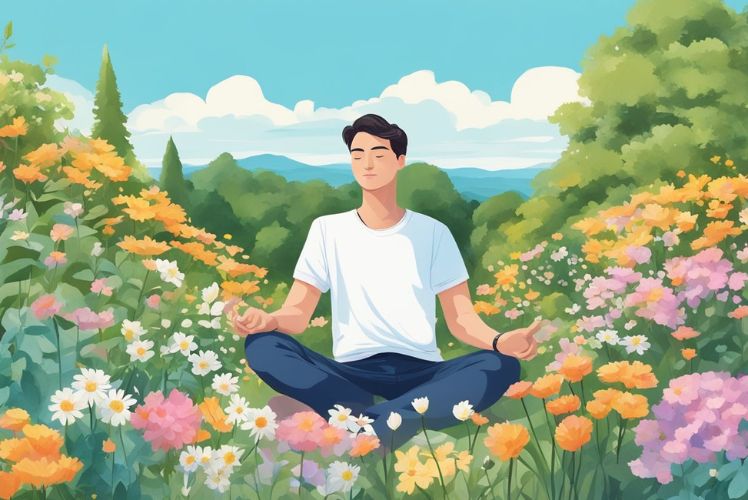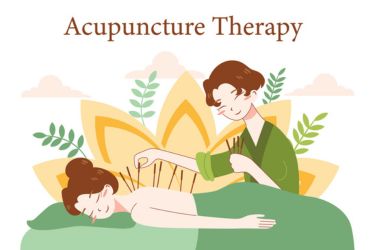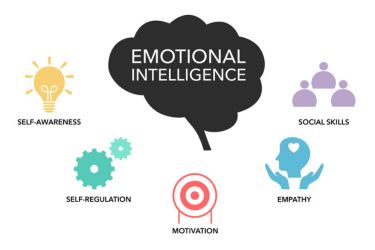Mindfulness and meditation are powerful tools we can use to manage anxiety and improve our mental health. By practising these techniques, we can learn to focus our thoughts and calm our minds, bringing greater peace into our lives. Many people struggle with anxiety on a daily basis, often feeling overwhelmed by constant worry. Integrating mindfulness into our daily routine can help us break this cycle and regain a sense of control.
The benefits of mindfulness and meditation have been supported by research. These practices not only reduce feelings of anxiety but also enhance our overall well-being. As we explore the fundamentals of mindfulness and practical techniques for meditation, we will discover how to create lasting change in our lives.
Key Takeaways
- Mindfulness can significantly reduce anxiety levels.
- Meditation techniques can improve focus and relaxation.
- A consistent mindfulness practice enhances our overall mental health.
Understanding Anxiety and Its Impact on Mental Health
Anxiety is a common experience that can significantly affect our mental health. We often see anxiety intertwined with stress, depression, and specific disorders like panic disorder and generalised anxiety disorder. It's important to explore these connections to better understand how anxiety impacts our lives.
Defining Anxiety and Stress
Anxiety involves feelings of worry, fear, or unease. It can occur in response to stress, which is our body’s reaction to any demand. When we encounter challenging situations, our body releases hormones that prepare us to respond.
While stress can be short-lived, anxiety may linger, leading to persistent feelings of apprehension. This ongoing anxiety can disrupt our daily lives, affecting our ability to function at work or enjoy leisure activities.
The Connection Between Anxiety and Depression
Anxiety and depression often coexist, creating a complex relationship. When we experience high levels of anxiety, we may become withdrawn, leading to feelings of sadness. This cycle can make it difficult for us to find joy in activities we once loved.
Both conditions share common symptoms, such as difficulty concentrating and changes in sleep patterns. Understanding this connection helps us recognise the importance of addressing both anxiety and depression for our mental health.
Generalised Anxiety Disorder and Panic Disorder
Generalised Anxiety Disorder (GAD) is characterised by excessive worry about various aspects of life, from work to health. We may often feel restless or easily fatigued. GAD can persist for months or years, making everyday tasks seem overwhelming.
Panic disorder, on the other hand, involves sudden, intense episodes of fear, known as panic attacks. These attacks can lead to physical symptoms like heart palpitations, sweating, and dizziness. Understanding these disorders is essential for recognising when to seek help and support.
Recognising the complexities of anxiety and its various forms is crucial in addressing our mental health. Understanding the signs and symptoms can lead to timely intervention and improved well-being.
The Fundamentals of Mindfulness
Mindfulness is a powerful practice that helps us connect with the present moment. To build a strong foundation in mindfulness, it’s essential to understand its core components: awareness, acceptance, and compassion.
What Is Mindfulness?
Mindfulness is the practice of paying focused attention to our experiences in the present moment. It involves observing our thoughts, feelings, and sensations without judgement. By being mindful, we create space to recognise our emotional responses, allowing us to respond more thoughtfully rather than react impulsively.
Mindfulness can be practiced at any time, whether we are eating, walking, or even talking. Its aim is to reduce anxiety and improve our overall wellbeing. Techniques like mindful breathing can help anchor our attention and enhance our awareness of the here and now.
The Role of Awareness in Mindfulness
Awareness is central to mindfulness. Through awareness, we learn to observe our thoughts and feelings as they occur. This helps us become conscious of patterns in our thinking.
When we notice our worries or anxieties, we can better manage them. We often engage in automatic ways of thinking, but by cultivating awareness, we step back from this automation. This can lead to clearer thinking and more balanced emotional responses.
Adopting practices like mindful breathing helps us stay anchored in the present, turning down the volume on distracting thoughts.
Acceptance and Compassion in Practice
Acceptance and compassion are key elements of mindfulness. Acceptance allows us to recognise our feelings without trying to change them. We learn to be okay with discomfort, understanding that it is a natural part of life.
Compassion extends this acceptance to ourselves. By treating ourselves with kindness during challenging moments, we cultivate a non-judgmental attitude. This creates a supportive environment for our personal growth and emotional healing.
Practicing acceptance and compassion helps us build resilience against stress. It allows us to face life’s challenges with greater ease and a more balanced perspective. By integrating these principles, we enhance the effectiveness of our mindfulness practice.
Mindfulness Meditation Techniques
To manage anxiety effectively, we can explore various mindfulness meditation techniques. These methods help us connect with our thoughts and feelings while promoting relaxation. Each technique offers unique approaches to focus and calm the mind, making them valuable tools for our mental wellbeing.
Breathing Exercises and Mindful Breathing
Breathing exercises are fundamental to mindfulness meditation. They help us centre our thoughts and ground ourselves in the present moment. One effective technique is deep breathing. We can start by inhaling deeply through our nose, allowing our abdomen to rise. Then, we slowly exhale through our mouth. This process can be repeated several times.
Mindful breathing involves paying attention to our breath pattern. We can count each breath to maintain focus. For instance, we might inhale for a count of four, hold for four, and then exhale for six. This practice calms our nervous system and reduces feelings of anxiety.
Body Scan Meditation
Body scan meditation allows us to develop a deeper awareness of our physical sensations. We begin by lying down comfortably, closing our eyes, and taking a few deep breaths. We slowly direct our focus to different parts of our body, starting from the toes and moving upward to the head.
As we focus on each area, we should notice any tension or discomfort. By acknowledging these feelings without judgment, we can encourage relaxation. This technique keeps us present and helps us understand how our body responds to stress, contributing to emotional health.
Mindful Pause and Focus Techniques
The mindful pause is a simple yet effective technique we can use daily. It involves creating a moment of stillness before we react to any situation. When we feel stressed or overwhelmed, we take a brief pause to gather our thoughts. This helps us avoid impulse reactions and respond more thoughtfully.
We can also practice focus techniques, such as visualisation. By picturing a calming scene or object, we engage our senses and shift our attention away from anxiety. This not only enhances focus but also promotes a sense of peace within us.
The Science of Meditation for Anxiety
Meditation offers us a powerful tool for managing anxiety. Research shows that practices like mindfulness help reduce stress and anxiety symptoms through various mechanisms, including physiological changes in the brain and improved emotional regulation.
Mindfulness-Based Stress Reduction (MBSR)
Mindfulness-Based Stress Reduction (MBSR) is a structured programme that combines mindfulness meditation and yoga. It was developed to help individuals cope with stress, pain, and anxiety. MBSR typically lasts for eight weeks and involves weekly group sessions and daily home practice.
Studies indicate that MBSR can lead to significant reductions in anxiety. Participants often report improved quality of life and heightened awareness of their thoughts and feelings. The practice encourages us to observe our thoughts without judgment, which can significantly decrease feelings of anxiety.
Anxiety Management through Mindfulness-Based Therapies
Mindfulness-based therapies utilise mindfulness techniques to help manage anxiety. These therapies often help us become more aware of our thoughts and feelings, allowing for better emotional control. Approaches like Mindfulness-Based Cognitive Therapy (MBCT) combine meditation with cognitive strategies to address anxious thought patterns.
Research shows that these therapies can be effective for those with anxiety disorders. They teach us how to respond to anxiety triggers in healthier ways. Regular practice can create long-lasting benefits, including reduced anxiety levels and improved coping strategies.
The Efficacy of Meditation for Anxiety Disorders
Meditation has been shown to be effective for various anxiety disorders, such as Generalised Anxiety Disorder (GAD) and Social Anxiety Disorder (SAD). Studies indicate that those who practice meditation regularly experience lower anxiety symptoms compared to those who do not.
Meditation promotes alterations in brain function, particularly in areas responsible for emotional regulation. For example, decreased activity in the amygdala, part of the brain associated with fear and anxiety, results in a greater sense of calm. Also, mindfulness practices enhance self-awareness, enabling us to understand our anxiety triggers better and respond more effectively.
Creating a Sustainable Mindfulness Routine
Maintaining a mindfulness routine is essential for enhancing our mental well-being and managing anxiety. By incorporating mindfulness into our daily lives, practising consistently, and exploring complementary activities like yoga, we can significantly improve our resilience and relaxation techniques.
Incorporating Mindfulness into Daily Life
We can easily include mindfulness in our everyday activities. Simple practices, such as mindful eating or attentive walking, can be effective. Mindful eating involves savouring each bite, paying attention to flavours and textures. While walking, we can focus on our surroundings—the sounds, the sights, and the feel of the ground beneath our feet.
To start, we might set aside a few minutes each day for deep breathing. This helps ground us in the present moment and calms our mind. Setting reminders on our phones can encourage us to pause and practise mindfulness throughout the day.
The Importance of Consistency and Practice
Regular practice is key to making mindfulness a habit. When we dedicate specific times for mindfulness exercises, we strengthen our ability to stay present. Aim for at least ten minutes each day to meditate or engage in focused breathing.
Tracking our progress in a journal can also be helpful. Writing about our feelings and experiences helps us reflect on our growth and areas for improvement. Over time, we’ll notice that consistency leads to greater relaxation and a deeper understanding of our thoughts and emotions.
Yoga and Other Complementary Practices
Incorporating yoga into our routine offers additional benefits for our mindfulness practice. Yoga enhances physical flexibility and helps alleviate stress. The various poses encourage us to focus on our breathing and bodily sensations, deepening our self-awareness.
We may also explore other relaxation techniques, like guided imagery or progressive muscle relaxation. These practices work alongside mindfulness to foster a calm mental state. Using online resources or apps can make it easy to follow along, providing structured guidance as we develop our routine.
By integrating these elements, we create a supportive framework for our mindfulness practice, allowing us to cultivate a greater sense of well-being and resilience.
Overcoming Challenges with Anxiety Relief
Managing anxiety can be a tough journey for many of us. We may encounter challenges like panic attacks, persistent phobias, or negative thoughts. By using effective strategies, we can make progress toward anxiety relief.
Dealing with Panic Attacks and Phobias
Panic attacks can feel overwhelming and often strike without warning. It’s important to recognise the signs, such as a racing heart or shortness of breath. When we feel these symptoms, we can use mindfulness techniques to calm our minds.
Deep breathing is a simple yet effective way to reduce stress during these moments. By focusing on our breath, we anchor ourselves in the present. This practice can also be helpful for phobias. Gradual exposure to the feared situation, combined with mindfulness, can help diminish our fear over time.
Positive Thinking and Affirmations
Positive thinking plays a crucial role in managing anxiety. We can challenge negative thoughts by replacing them with positive affirmations. Phrases like “I am capable” or “I can face my fears” can change our mindset.
Repeating these affirmations regularly reinforces our self-belief. Additionally, maintaining a gratitude journal can shift our focus from anxiety to appreciation. Writing down what we are thankful for can create a more positive outlook on life.
Working with a Mental Health Professional
We don’t have to face our challenges alone. Consulting with a mental health professional can provide valuable support. They can offer therapies such as cognitive behavioural therapy (CBT) or mindfulness therapy tailored to our needs.
Working with a professional gives us tools to manage stress and anxiety effectively. They can guide us in identifying triggers and developing coping strategies. This partnership can be a significant step toward overcoming anxiety and improving our mental health.
Enhancing Overall Wellbeing
Mindfulness and meditation can significantly improve our wellbeing by addressing both our physical and emotional health. Through practices such as meditation, we can foster a sense of inner peace, better regulate our emotions, and enjoy lasting benefits for our mental wellbeing.
The Role of Physical Health in Reducing Anxiety
Maintaining good physical health is essential for reducing anxiety. Regular exercise boosts endorphin levels, which can enhance our mood and decrease feelings of stress. A balanced diet rich in nutrients supports our body and mind, allowing us to cope better with anxiety.
We may also find that sufficient sleep plays a crucial role in our emotional resilience. When we rest well, our capacity to handle stressors improves. Incorporating activities that promote physical health, such as yoga and mindful walking, can harmonise our body and mind, leading to improved self-acceptance and overall wellbeing.
Emotional Regulation and Inner Peace
Practising mindfulness helps us develop emotional regulation skills. When we become more aware of our thoughts and feelings, we can respond to them without judgement. This process promotes self-compassion and helps us cultivate inner peace.
Mindful meditation teaches us to observe our emotions, allowing us to differentiate between what we can control and what we cannot. As we learn this skill, we may find it easier to navigate our emotional responses. Over time, this practice leads to a more balanced approach to life’s challenges, increasing our overall mental wellbeing.
Long-Term Benefits of Mindfulness and Meditation
The long-term benefits of mindfulness and meditation extend far beyond temporary relief. Research indicates that consistent practice can lead to lasting improvements in our mental health. This includes reductions in anxiety and depression symptoms.
Additionally, we may experience heightened self-acceptance and greater resilience in the face of stress. Mindfulness encourages us to embrace our thoughts and emotions rather than avoiding them. As we cultivate this acceptance, we foster a profound sense of wellbeing that permeates our daily lives. With time, we can build a strong foundation for emotional stability and mental growth.
Frequently Asked Questions
In this section, we will explore important questions related to mindfulness and meditation for anxiety relief. We will discuss effective techniques, daily practices, supporting evidence, and specific approaches tailored to manage anxiety.
What are effective meditation techniques for managing stress and anxiety?
We find that techniques such as guided meditation, deep breathing exercises, and progressive muscle relaxation can be very effective. These methods help calm the mind and body. Additionally, mindfulness practices enable us to focus on the present moment, which can significantly reduce anxiety.
How can I implement a short, daily meditation practice to alleviate anxiety?
To begin a daily meditation practice, we can set aside just five to ten minutes each day. Finding a quiet space, we may choose to sit comfortably and focus on our breath. Gradually, we can increase the duration as we become more comfortable with the practice.
Is there any evidence that mindfulness meditation can alleviate symptoms of anxiety?
Research shows that mindfulness meditation can help reduce anxiety symptoms. Studies suggest that regular practice can lead to changes in brain structure, improving emotional regulation and resilience. As we engage in mindfulness, we are likely to experience less stress and greater clarity.
What is mindfulness, and how does it differ from traditional meditation when applied to anxiety relief?
Mindfulness involves being fully present in the moment without judgement. Unlike traditional meditation, which may focus on a specific object or thought, mindfulness encourages us to observe our thoughts and feelings as they arise. This approach can help us acknowledge anxiety without becoming overwhelmed by it.
Are there guided meditations that specifically target anxiety and depression?
Yes, we can find various guided meditations designed for anxiety and depression relief. These meditations often include calming narratives and specific techniques to help us cope with distress. Many apps and online platforms offer these resources for easy access.
How does one practice the 3-3-3 rule for managing anxiety?
The 3-3-3 rule is a simple technique to help ground us when feeling anxious. We can look around and identify three things we see, three things we can touch, and three things we hear. This technique encourages us to focus on our surroundings and can help shift our attention away from anxious thoughts.





















